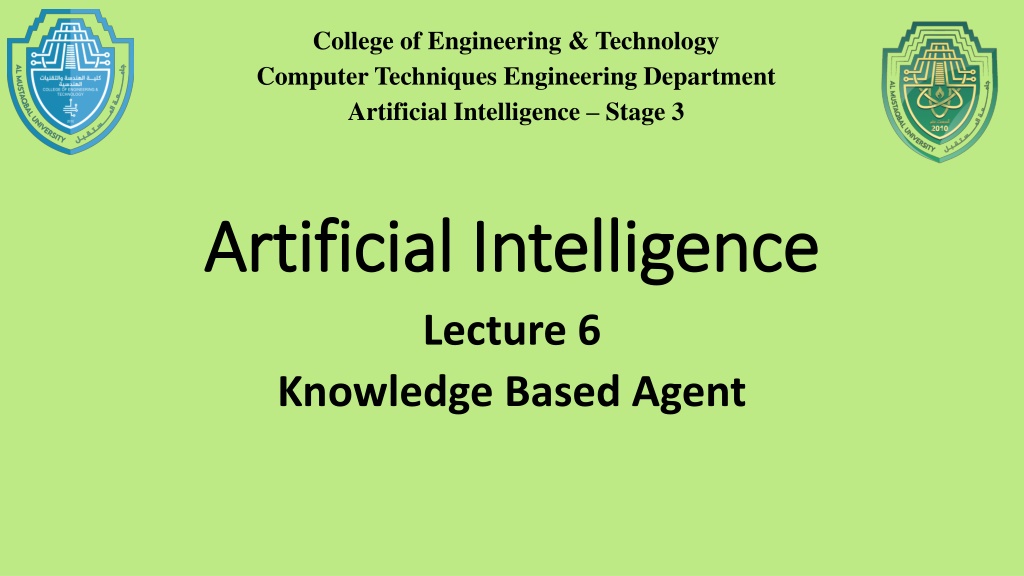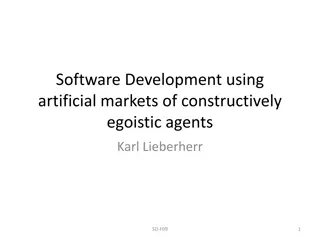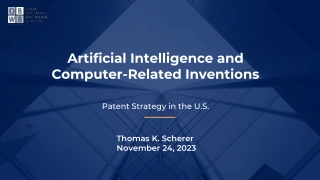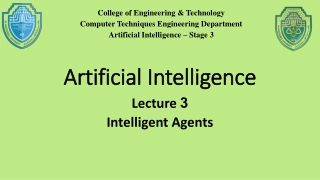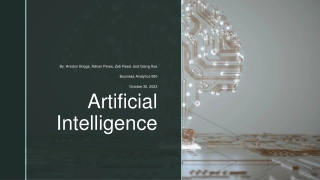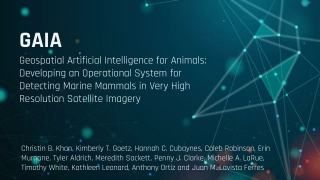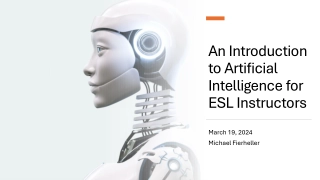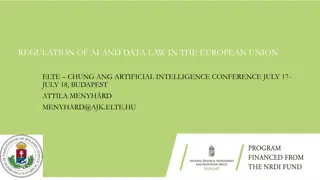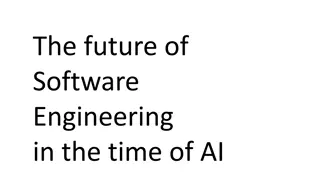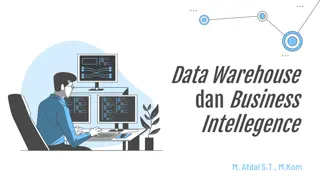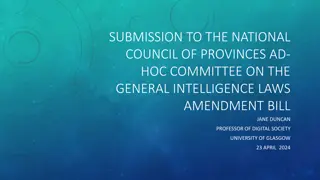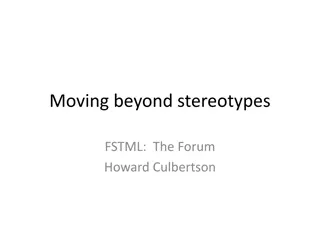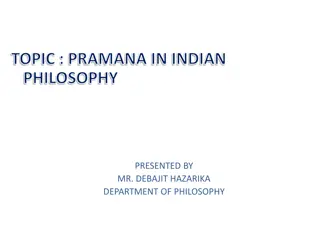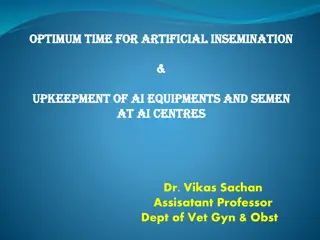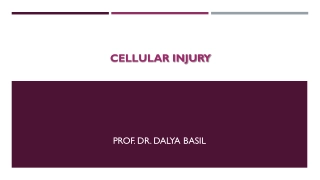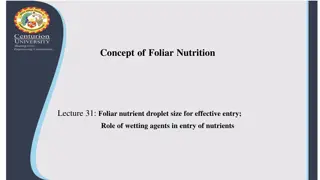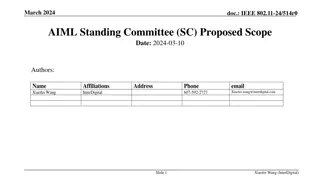Understanding Knowledge-Based Agents in Artificial Intelligence
Knowledge-Based Agents in AI utilize logic and knowledge representation to accept tasks, learn, and adapt to changing environments. Logic plays a crucial role in forming complex world representations and deriving actions based on inference. The central component is the Knowledge Base (KB), represented by sentences in a Knowledge Representation Language.
Download Presentation
Please find below an Image/Link to download the presentation.
The content on the website is provided AS IS for your information and personal use only. It may not be sold, licensed, or shared on other websites without obtaining consent from the author. Download presentation by click this link. If you encounter any issues during the download, it is possible that the publisher has removed the file from their server.
Presentation Transcript
College of Engineering & Technology Computer Techniques Engineering Department Artificial Intelligence Stage 3 Artificial Intelligence Artificial Intelligence Lecture 6 Knowledge Based Agent
Knowledge Based Agent Knowledge Based Agent Humans know things and what they know helps them to do things. Human intelligence not purely reflex mechanisms but by process of reasoning that operation of the internal representation of knowledge. In AI this approach to intelligence is embodied in Knowledge-based Agents
Knowledge Based Agent Knowledge Based Agent Logic is used as a form of knowledge representation. Knowledge-based agents can: accept new task in form of explicitly describe goals. Achieve competence quickly by being told or learning new knowledge about the environment. They can adapt to changes in the environment by updating the relevant knowledge.
Knowledge Based (Logical Agent) Agent Knowledge Based (Logical Agent) Agent In which we design agents that can: Form representations of a complex world. Use a process of inference to derive new representation about the world Use this new representation to deduce what to do.
Knowledge Based (Logical Agent) Agent Knowledge Based (Logical Agent) Agent The central component of a knowledge-based agent is Knowledge Base (KB). A knowledge Base is a set of sentences. Each sentence is expressed in a language called Knowledge Representation Language
Knowledge Based (Logical Agent) Agent Knowledge Based (Logical Agent) Agent Knowledge Representation Language represents some assertion about the world. Sometimes we dignify a sentence with the name axiom. (when the sentence is taken as given without being derived for other sentences)
Knowledge Based (Logical Agent) Agent Knowledge Based (Logical Agent) Agent There must be a way to add new sentence to the knowledge base. There must be a way to query the knowledge base. The standard name for these operations are TELL & ASK Both operation may involve inference (driving new sentence from old )
Knowledge Based Agent Program Knowledge Based Agent Program Figure shows the outline of KB agent program.
Knowledge Based Agent Program Knowledge Based Agent Program Each time agent program is called, it does three things: 1. It TELLs the knowledge base what it perceives. 2. It ASKS the knowledge base what action is should perform. ( extensive reasoning required) 3. The agent program tell the KB which action was chosen, and agent executes the action.
LOGIC LOGIC The fundamental concepts of logical representation and reasoning 1. Syntax 2. semantic 3. Model 4. Logical Reasoning (entailment), 5. Sound (truth preserving) 6. completeness 7. grounding.
LOGIC (Syntax) LOGIC (Syntax) Knowledge base consist of sentences. These sentences are expressed according the syntax of the representation language. Syntax specifies all the sentences are well formed. X+Y = 4 X4Y+=
LOGIC (semantics) LOGIC (semantics) Logic must also define the semantic (meaning) of sentences. The semantic defines the truth of each sentence with respect to each possible world. For example the semantic of the following arithmetic sentence ( X + Y = 4) is true where X is 2 and Y is 2. Note: in standard logic every sentence must be either true or false in each possible world (model).
LOGIC (model) LOGIC (model) We use the term model in place of possible world. Possible world might be thought of as potentially real environments. Models are mathematical abstractions fixes the truth of false of every relevant sentence Possible models are just all possible assignments of real numbers to the variable x and y
LOGIC (model) LOGIC (model) If sentence is true in model m, we sat that m satisfies m is a model of We us the notation M( ) to mean the set all models of
LOGIC (logical reasoning) LOGIC (logical reasoning) What is the entailment between sentences. The idea that a sentence follows logically from another sentence. In mathematical notation we write. This mean the sentence entail the sentence
LOGIC (logical reasoning) LOGIC (logical reasoning) The formal definition of entailment is If and only if , in every model in which it true is also true if and only if M( ) M( )
LOGIC LOGIC An inference algorithm that derives only entailed sentences is called sound or truth preserving. Soundness is a highly desirable property. The property of completeness is also desirable, an inference algorithm is complete if it can derive any sentence that is entailed.
LOGIC LOGIC The final issue to consider is grounding, the connection between logical reasoning process and the real environment in which the agent exists. In particular, how do we know that KB is true in the real world? A simple answer is that the agent s sensors cerate the connections.
Thanks for Your Attention Thanks for Your Attention
